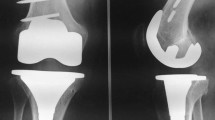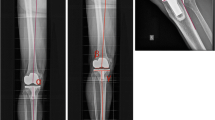Abstract
Introduction
Within a 15-month period, 64 patients underwent 71 primary total knee arthroplasties in a randomized trial comparing the navigated versus the conventional implantation technique. CT scans were chosen for use as imaging procedures pre- and post-operatively to collect data concerning alignment and rotation of the leg as well as the prosthesis.
Results
There was no difference between pre- and post-operative data in rotation of the femoral component for navigated versus conventional implantation. The average deviation from the correct long-leg axis was found to be 1.8 ± 1.3° in the navigated group and 2.5 ± 1.6° in the conventional group (P < 0.05).



Similar content being viewed by others
References
Bargren JH, Blaha JD, Freeman MA (1983) Alignment in total knee arthoplasty. Clin Orthop 173:178–183
Clemens U, Miehlke RK, Kohler S, et al (2003) Computer assisted navigation with the OrthoPilot-system and the search-evolution-knee prosthesis. Results of a multicenter study. In: Konermann W, Haaker R (eds) Navigation und Robotik in der Gelenk- und Wirbelsäulenchirurgie. Springer, Berlin, Heidelberg, New York, Tokio, pp 207–216
Coull R, Bankes MJK, Rossouw DJ (1990) Evaluation of tibial component angles in 79 consecutive total knee arthroplasties. Knee 6:235–237
Crossett LS (2002) Fixed- versus mobile-bearing total knee arthroplasty: technical issues and surgical tips. Orthopaedics 25(2 Suppl):251–256
Fujiko R, Kotten B, Zettl R, Ritschl P (2004) The accuracy of palpation from orientation points for the navigated implantation of knee prostheses. Orthopäde 33:338–343
Hauser R (2000) Computer-aided 3D-navigation systems—a plea for an error model. HNO 48(2):71–74
Insall JN, Dorr LD, Scott R, Scott WN (1989) Rationale of the knee society clinical rating system. Clin Orthop 248:13–14
Janecek M, Bucek B, Hart R (2001) OrthoPilot (Aesculap)—Computernavigation der Endoprothese des Kniegelenks. Acta Chir Austriaca 33:175
Jeffrey RS, Morris RW, Denham RA (1991) Coronal alignement after total knee replacement. J Bone Joint Surg 73B:709–714
Jenny JY, Boeri C (2001) Computerassisted implantation of a total knee arthroplasty: a case-controlled study in comparison with classical instrumentation. Rev Chir Orthop Reparative Appar Mot 87/7:645–652
Jerosch J, Peuker E, Philipps B, Filler T (2002) Interindividual reproducibility in perioperative rotational alignment of femoral components in knee prosthetic surgery using the transepicondylar axis. Knee Surg Sports Traumatol Arthrosc 10:194–197
Kienapfel H, Springorum HP, Ziegler A, et al (2003) Effect of rotation of the femoral and tibial components on patellofemoral malalignment in knee arthroplasty. Orthopäde 32/4:312–318
Konermann W, Saur MA (2003) Postoperative alignment of conventional and navigated implantation of TKA. In: Konermann W, Haaker R (eds) Navigation und Robotik in der Gelenk- und Wirbelsäulenchirurgie. Springer, Berlin, Heidelberg, New York, Tokio, pp 189–198
Krackow KA, Pepe CL, Galloway EJ (1990) A mathematical analysis of the effect of flexion and rotation on apparent varus/valgus alignment at the knee. Orthopedics 13(8):861–868
Lampe F, Honl M, Wieman R, Hille E (1999) Computergestützte navigation gelenkerhalt und Endoprothetik bei gonarthose. In: Implant 2—1999 Kasuistik. Springer, Berlin, Heidelberg, New York, Tokio
Mahoney FL, Barthel DW (1965) Activities of daily living. Md State Med J 14/2:61–65
Mielke RK, Clemens U, Jens JH, Kershally S (2001) Navigation in knee prosthesis implantation—prelaminary experiences and prospective comparative study with conventional implantation technique. Z Orthop 139:109–116
Oberst M, Bertsch C, Lahm A, Wuerstlin S, Holz U (2006) Regression and correlation analysis of preoperative versus intraoperative assessment of axes during navigated total knee arthroplasty. Comp Aid Surg 11(2):87–91
Oberst M, Bertsch C, Wuerstlin S, Holz U (2003) CT-analysis of leg alignment after free hand and navigated TKA: prelaminary results of a controlled, prospective and randomised study. Unfallchir 106:941–948
Olcott CW, Scott RD (1999) The Ranawat award. Femoral component rotation during total knee arthroplasty. Clin Orthop 367:39–42
Olcott CW, Scott RD (2000) Determining proper femoral component rotational alignment during total knee arthroplasty. Am J Knee Surg 13/3:166–168
Olcott CW, Scott RD (2000) A comparison of 4 intraoperative methods to determine femoral component rotation during total knee arthroplasty. J Arthroplasty 15/1:22–26
Perlick L, Bäthis H, Tingart M, Perlick C, Grifka J (2004) Navigation in total-knee arthroplasty: CT-based implantation compared with the conventional technique. Acta Orthop Scand 75(4):464–470
Rand JA, Coventry MB (1988) Evaluation of geometric total knee arthroplasty. Clin Orthop 232:168–173
Robertsson O, Dunbar M, Pehrsson T, Knutson K, Lidgren L (2000) Patient satisfaction after knee arthroplasty: a report on 27,372 knees operated on between 1981 and 1995 in Sweden. Acta Orthop Scand 71(3):262–267
Ritter MA, Faris PM, Keating EM, Meding JB (1994) Postoperative alignement of total knee replacement. Its effect on survival. Clin Orthop 299:153–156
Saragaglia D, Picard F (2003) Computergestützte Implantation von Knietotalendoprothesen ohne präoperative bildgebende verfahren: das kinematische Modell. In: Konermann W, Haaker R (eds) Navigation und robotik in der gelenk- und Wirbelsäulenchirurgie. Springer, Berlin, Heidelberg, New York, Tokio, pp 199–206
Saragaglia D, Picard F, Chaussard C (2001) Computer-assisted knee arthroplasty: comparison with a conventional procedure. Results of 50 cases in a prospective randomised study. Rev Chir Orthop Repatrice Appar Mot 87/1:18–28
Sparmann M, Wolke B, Czupalla H, Banzer D, Zink A (2003) Positioning of total knee arthroplasty with and without navigation support. A prospective randomised study. J Bone Joint Surg Br 85(6):830–835
Swanson KE, Stocks GW, Warren PD, Hazel MR, Janssen HF (2000) Does axial limb rotation affect the alignment measurements in deformed limbs? Clin Orthop 371:246–252
Tew M, Waugh W (1985) Tibial-femoral alignement and the results of knee replacement. J Bone Joint Surg 67B:551–556
Waidelich HA, Strecker W, Schneider E (1992) Computed tomographic torsion-angle and length measurement of the lower extremity. The methods, normal values and radiation load. RoFo 157/3:245–251
Yoshino N, Takai S, Ohtsuki Y, Hirasawa Y (2001) Computer tomography measurement of the surgical and clinical transepicondylar axis of the distal femur in osteoarthitic knees. J Arthroplasty 16(4):493–497
Author information
Authors and Affiliations
Corresponding author
Rights and permissions
About this article
Cite this article
Oberst, M., Bertsch, C., Konrad, G. et al. CT analysis after navigated versus conventional implantation of TKA. Arch Orthop Trauma Surg 128, 561–566 (2008). https://doi.org/10.1007/s00402-007-0486-5
Received:
Published:
Issue Date:
DOI: https://doi.org/10.1007/s00402-007-0486-5




